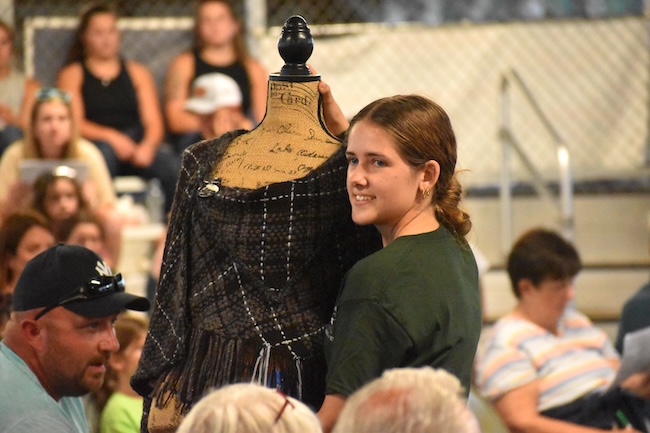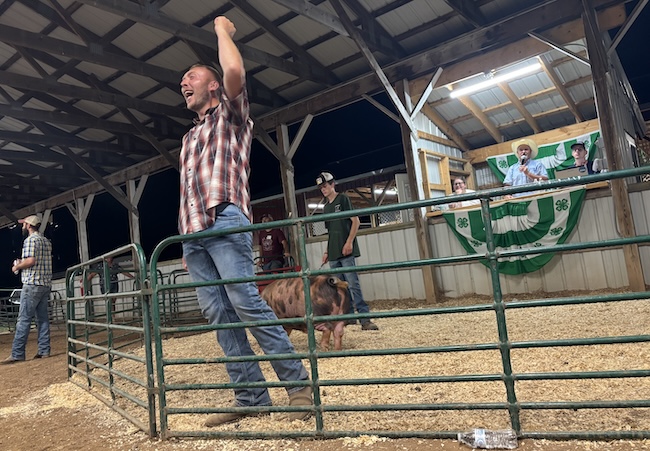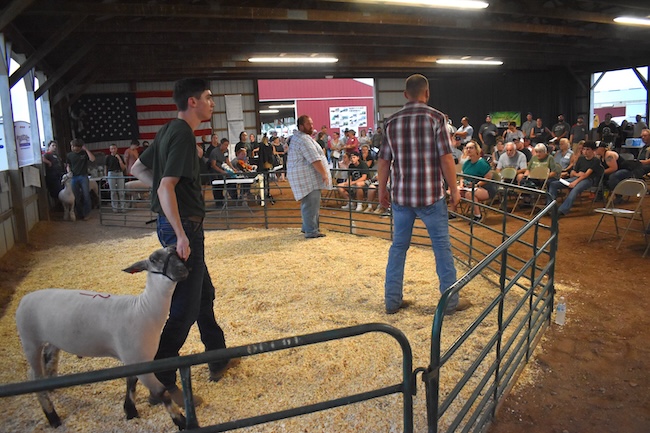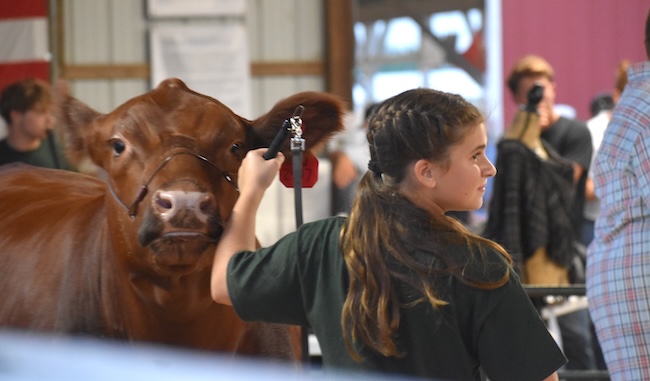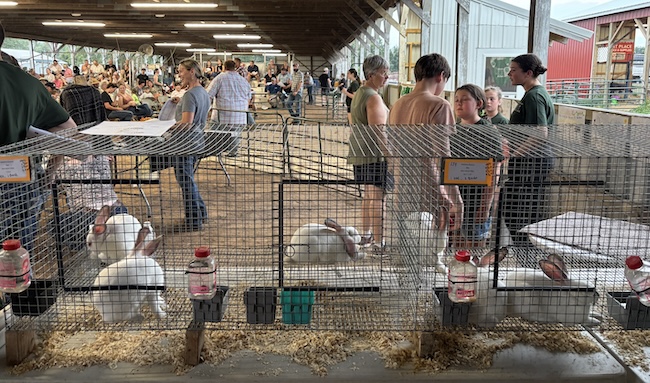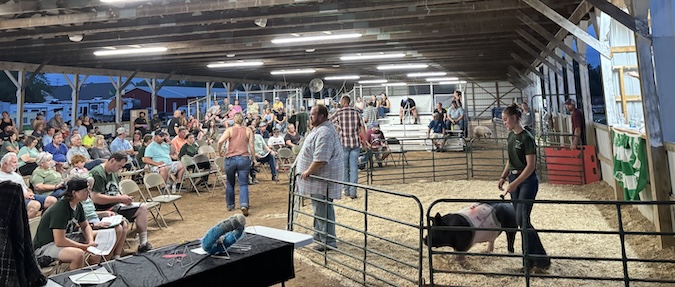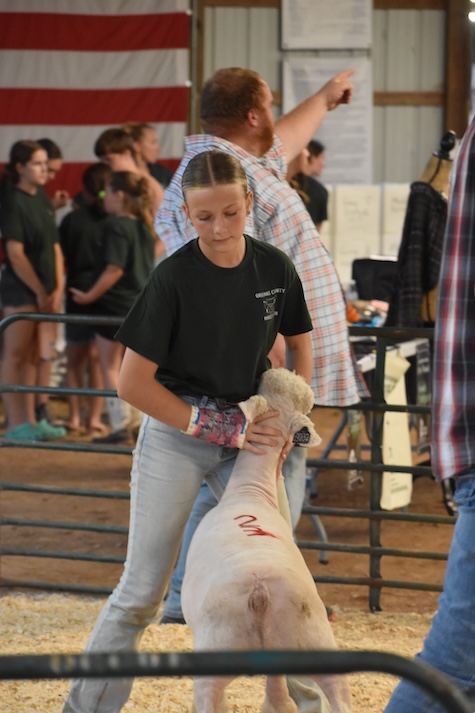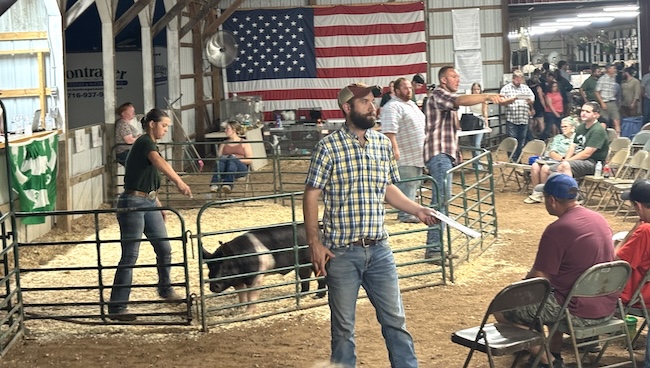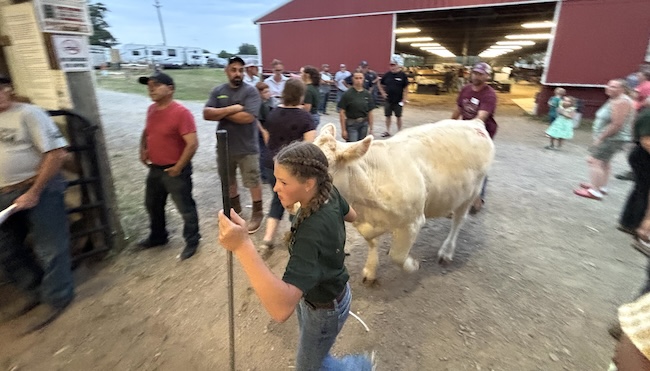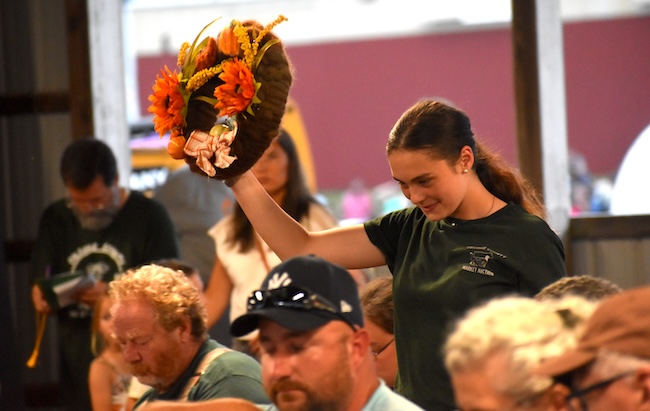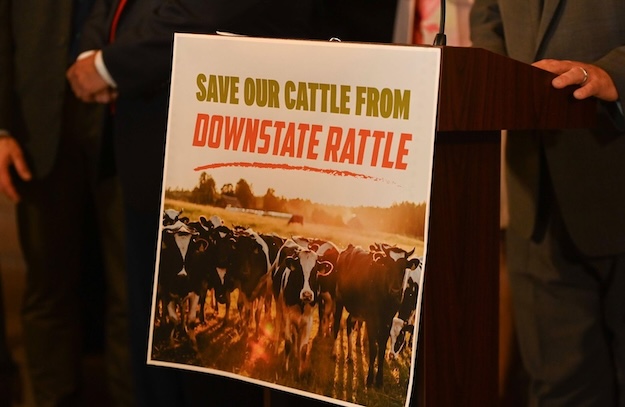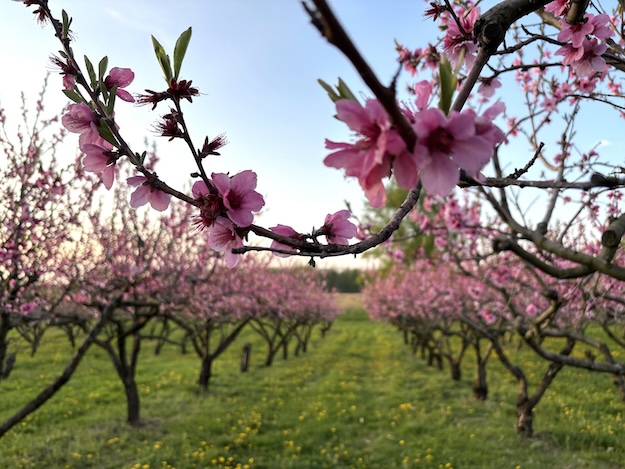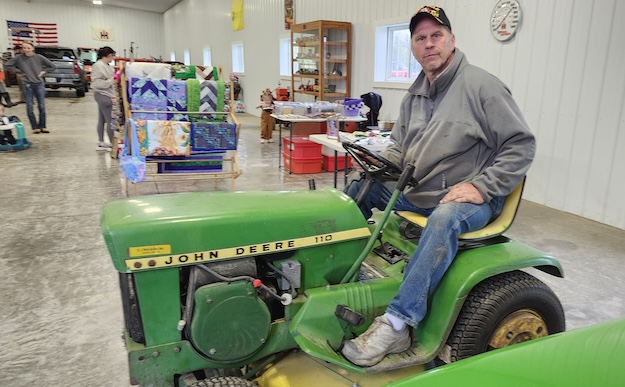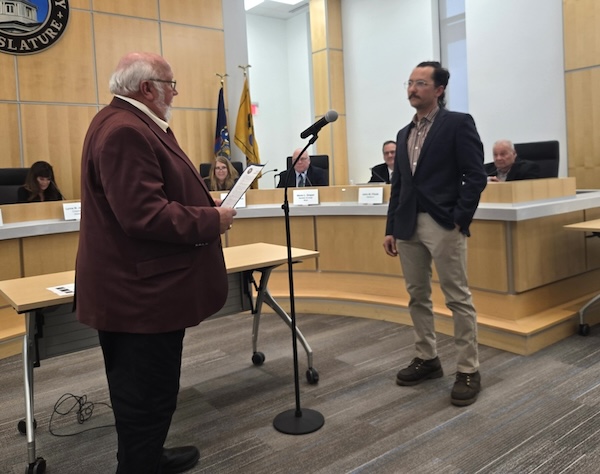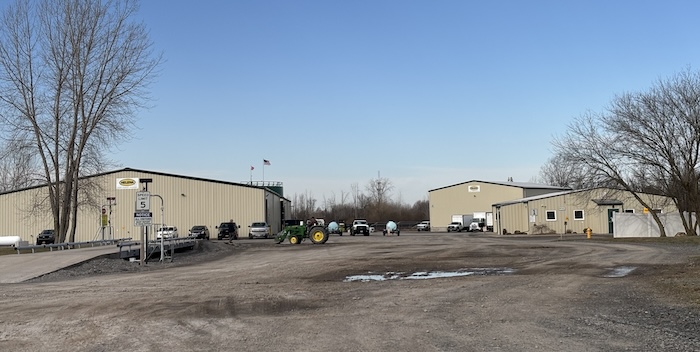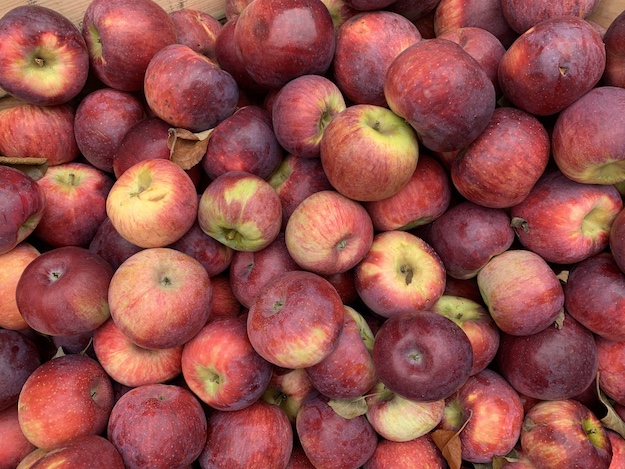4-H Market Auction smashes record with generous bidders stepping up
$139,852 more than doubles last year’s record of $64,128
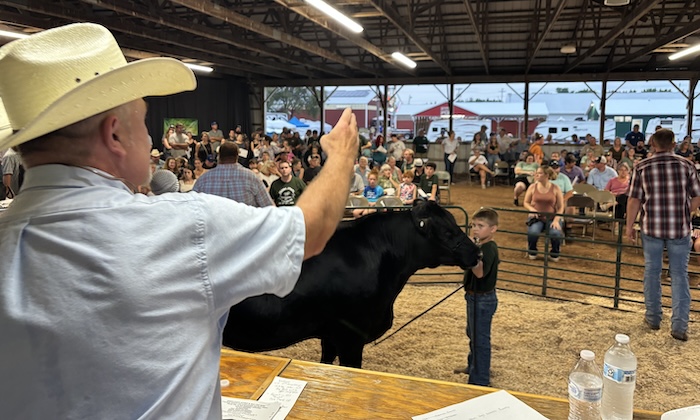
Photos by Tom Rivers: Lane Miller, 9, of Lyndonville has the grand champion steer in the ring during Saturday’s Market Auction. Lane raised the 1,465-pound beef animal, one of 12 beef cattle in the auction, up from four last year. Todd Jantzi, auctioneer with Bontrager Real Estate & Auction Service in Batavia, gets the bids going up for Lane’s steer. Western New York Energy paid $7 per pound, well above the market price. Jantzi is owner and president of Bontrager and serves as auctioneer at four market auctions at county fairs.
KNOWLESVILLE – Saturday’s Market Auction to cap the Orleans County 4-H Fair was a record-breaker.
4-Hers sold animals, fiber and even cookies that brought in $139,852. That obliterated the previous record high set last year at $64,128. The auction typically was bringing in $20,000 to $28,000 until the recent jump.
There were many more 4-Hers they entered animals and their fiber creations for the auction, and those kids brought more energy and bidders to the event, committee members said.
The big crowd of budders was a relief to the 4-Hers and their parents. Some of the them were worried that so many more animals in the auction could lead to smaller prices. But the 4-Hers were able to recruit more bidders, and many of the mainstays in recent years were back with open wallets.
Carissa Klossner of Holley made this shawl out of 100 percent alpaca yarn. Matt Hughson of the Redtail Cattle Company paid $260 for it. The fiber products where introduced to the auction for the first time last year.
“I 100 percent support 4-H,” Hughson said. “Every 4-Her is important and they all deserve it.”
Zack Welker, one of the callers, maintained high energy during the 2 ½-hour auction. Here he signals the bids are going up for a pig by Jacob Forte, 18, of Hamlin. There were 27 pigs in the auction, up from 19 last year.
Hugh Gabalski, 18, of Byron leads the grand champion lamb in the ring. It was bought by Joe Sidonio for $570. Hugh said he was happy to see the high bids for the animals at the auction. He said in some years, especially the online auction during Covid in 2020, he lost money or barely broke even.
“In 2020, the prices were dirt cheap,” Gabalski said.
Hugh said he has used the profits to buy and raise other animals over the years, and has been able to save some of the money for college.
Natalie Miller, 11, of Lyndonville keeps her 1,300-pound steer steady in the show ring.
It was purchased by Jed Torrey of Torrey at $6.75 a pound. Torrey said Natalie visited Torrey Farms in Elba, asking Torrey’s to consider bidding on her steer. Torrey said the personal visit made a big difference.
“It’s good to support the kids because they really do work hard,” Torrey said.
Travis Walton, owner of Walton Manure Management based in Linwood, holds up his number after being the winning bidder, paying $13 per pound for a pig raised by Natalie Miller.
Walton does manure work for Chaffee Farms, where Natalie’s dad is a partner. Natalie met Walton at the farm and asked him to come to the market auction.
Walton was a 4-Her as a kid in Genesee County. Saturday was his first time at the Orleans County 4-H Fair.
He said Natalie’s personal request to attend the fair made the difference in him going and spending over $3,000 for her pig.
“She reached out,” he said. “It’s hard to say no to a young kid.”
There were eight lots of rabbits up for bid, plus four lots of turkeys, and five lots of chickens.
Dana Watson of Watson Enterprises smiles after paying over $6,000 for a pig raised by Lane Miller, 9, of Lyndonville. Watson paid $24.50 per pound for the pig, the biggest bid of the night among the pigs in the auction.
Watson Enterprises has built buildings for Chaffee Farms in Barker, where Lane’s dad Corey Miller is a co-owner.
Ruth Kuipers, 15, of Byron has her pig in the arena while Andy Beach and Zack Welker call out the bids. The Market Auction culminates several months of work with the animals by 4-Hers.
Madeleine Farrell of Holley holds a sign for a pen of two chickens that were auctioned off for $250. Auctioneer Todd Jantzi is in back with Janie (Schutz) Ledbetter, left, and Nicole Mrzywka. Andy Beach, in front, served as one of the ring men to track bids from the crowd.
Jantzi said the hard work by kids over many months paid off. They need to do a good job raising the animals and making their products for the auction. But they also need salesmanship – as well as showmanship.
“It’s how the kids get out and knock on doors,” Jantzi said. “That’s what makes the difference.”
Susan Hanson, right, paid $150 for a loom knit hat made by 4-Her Ginny Schofield.
Lena Grillo, 13, of Albion had a blue-ribbon lamb that was the top seller in the auction, getting over $8 per pound.
Kate Bennett of Brockport had two pigs in the auction and both were purchased by her grandfather, Tony Piedimonte of Piedimonte Farms in Holley. The ring men eyeing the crowd for bids include Chris Flansburg in front, and Zack Welker and Andy Beach in back.
Isabel Nesbitt, 12, of Lyndonville leads her beef animal into the barn for the market auction.
Megan Hartway made a successful bid at $3.75 per pound for a 1,120-pound beef steer raised by Isabel Nesbitt of Lyndonville. Hartway bid for her husband Nate, who is a crop consultant with Nutrien Ag Solutions in Fancher.
Mrs. Hartway said her kids weighed in on which animal to buy at the auction. They liked Isabel’s steer, a white animal she named Marvin.
“We want to support 4-H, and our kids thought it was just the prettiest white cow,” Mrs. Hartway said.
Helen Schofield of Holley holds up a wreath she made with a festive fall theme. The wreath sold for $110 at the auction.

















